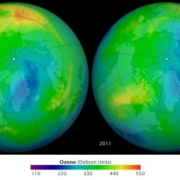Successes of the Montreal Protocol
The Montreal Protocol
This month marks the 26th anniversary of the Montreal Protocol, one of the most successful international treaties that has, among other things, reduced the amount of carbon dioxide emitted into the atmosphere. Forests are also critical in meeting the challenge of total emissions reductions through their ability to act as carbon sinks and safely remove carbon dioxide, CO2, from the atmosphere. Trees help the planet by absorbing carbon dioxide. They release the oxygen back into the environment and use the carbon internally, to produce sugars for growth. Trees continue to store carbon, keeping it out of the atmosphere for the duration of its use, and those benefits are extended when those wood products are recycled time and time again. For more resources on the sustainability of North American forests, visit the reference section at the bottom of this page.
History
The ozone layer acts as a shield to protect Earth and all the plants and animals within it from ultraviolet radiation. In the 1970’s, scientists learned that chlorofluorocarbons, or CFC’s, had been migrating to the upper atmosphere, depleting the ozone layer.
The scientists involved in the initial discovery, Mario Molina and F. Sherwood Rowland, went on to receive the Nobel Prize in Chemistry for their work concerning the formation and depletion of the ozone layer. However, during the 1970’s, CFC’s were commonly found in household products like hairspray and deodorant. Years later in 1985, scientists discovered that the Antarctic ozone hole, a layer of ozone above the Antarctic, had been shrinking at higher rates than they originally calculated and it was proved that the widespread use of CFC’s had caused it. The international community responded with the Montreal Protocol to eliminate the production and sale of ozone-harming substances.
According to the United Nation’s Environment Programme, below are some of the successes of the Montreal Protocol
- The ozone layer is recovering. It should return to pre-1980 levels by the middle of the century
- It has helped the global community avoid millions of cases of fatal and non-fatal skin cancer, and cataracts
- As of 2010, the consumption and production of ozone depleting substances has stopped
- It became the first treaty to be universally ratified
Paris Agreement of 2015
Since CFC’s and other ozone depleting substances are also global warming gasses, the reduction of one helped reduce the other. However, there’s still work to be done. Scientists estimate that the size of the Arctic ozone hole won’t return to pre-1970 levels until the middle of the 21st century, so the full impact of the Montreal Protocol might not be realized for at least another forty years. Moreover, the planet is still warming. At the Paris Climate Conference in December of 2015, 195 countries agreed to a global action plan that will limit global warming to below 2 degrees Celsius. This historic breakthrough is the result of nine years of United Nations diplomats working together to stop global warming, requiring action from all countries. In an interview, the UN secretary general Ban Ki-moon said, “For the first time, we have a truly universal agreement on climate change, one of the most crucial problems on earth.”


